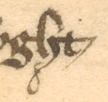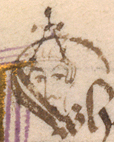|
| A |
 | Usage: pale
lower case 'a' is almost invariably of this squarish formation. |  | Usage: And
this scribe has several upper case 'A's but this one with squared off upper lobe is frequently used. |
 | Usage: And
variations on this form of 'A' are found frequently in documents copied by Hoccleve. |  | Usage: And
a more elaborate version of the previous 'A'. The scribe appears to experiment with many of his 'A' graphs. |
|
| D |
 | Usage: hadde
the typical formation of the looped 'd' graph. |  | Usage: Iqd
'd' in final position with tag used rarely on these folios. |
 | Usage: fide
'd' in the display script used for rubrics in the scribe's hand. |  | Usage: Dispent
upper case letter at the beginning of a line. |
|
| G |
 | Usage: lenger
a very angular form of 'g' which is used as standard in this manuscript. |  | Usage: walkyng
'g' with addendum perhaps for extra 'e'. |
 | Usage: gracious
when 'g' is on the bottom line, the scribe frequently extends and curls the tail. Here the word is within the body of the verse but the address to Prince Henry at the beginning of the 'Regimine' perhaps encouraged a more elaborate treatment. |  | Usage: God
upper case letter at the beginning of a line. |
|
| H |
 | Usage: hem |  | Usage: swych
'h' is rarely crossed on the sampled folios. Here the graph is crossed when in the 'ch' combination. |
 | Usage: ryght
note the treatment of the tail-stroke. This is a feature which the scribe uses on several graphs, perhaps to provide a decorative effect. |  | Usage: Hoccleue
although not always present on upper case 'H' it is just possible to see the loop to the left of the stem beneath the red and blue used for the paraphs and the tail-stroke of 'h' from the line above which cuts through the top of the graph. |
|
| R |
 | Usage: reste
'r' in initial position. The image shows the size of 'r', sitting just above the line and at the same level as the following graph. The scribe's 'r's frequently sit on the line. |  | Usage: sory
'z'-shaped 'r' almost always appears with otiose stroke. Used frequently not only after 'o'. |
 | Usage: preyer
an example of the lengthened 'r' graph, here with flourish perhaps to replace final 'e'. |  | Usage: Ryȝt
an elaborate upper case graph at the beginning of a line. |
|
| S |
 | Usage: eres
kidney-shaped 's' used consistently in final position. |  | Usage: so
long 's' used in initial and medial positions. The stem of 's' is not extended very much below the lower level of the body of the text. |
 | Usage: prologus
final 's' in the scribe's display script used for rubrics. |  | Usage: Syn
upper case letter at the beginning of a line. |
|
| W |
 | Usage: werk
on these folios 'w' varies little in formation, although some graphs seem more spikey than others. |  | Usage: wyght
a more rounded graph. |
 | Usage: wt
the superscript letter is just above the graph. |  | Usage: Wyth
upper case graph with more open head-strokes and spiked left arm. |
|
| Y |
 | Usage: yt
'y' is almost always dotted. |  | Usage: by
the tail of 'y' has numerous variations as may be seen in the examples shown here. |
 | Usage: Thys
'y' with straight stroke as a tail. |  | Usage: prye |
|
| Thorn and Yogh |
 | Usage: þey
thorn is not used consistently. It is used for initial 'th' in definite articles, pronouns, abbreviation for 'that' etc. However, there is no definite pattern and the use of thorn may be associated with length of line. |  | Usage: wiþ
thorn is also used in final position for 'th', in words such as 'with' as here or for verb endings. The stem of thorn slants backwards slightly. |
 | Usage: thouȝt
yogh again is not used consistently but is in the scribe's repertoire when he wishes to use it. Here it is used as representative of the 'gh' sound. |  | Usage: Ȝyt
yogh used initially as representative of the 'y' sound. |
|
| Upper Case Oddities |
 | Usage: Whan
a variation on 'W' at the beginning of a stanza with wide upward sweep of the arms of the graph. |  | Usage: A
yet another variation on 'A' with distinctive foot at the base of the right arm, also found in many documentary hands. |
 | Usage: Passe
upper case 'P' again at the beginning of a stanza. A lozenge-shaped dot in the centre of the graph. The hooked stroke to the left of the graph is frequently added to other upper case letters at the beginning of lines. |  | Usage: Explicit
a serrated letter at the beginning of the Explicit. |
|
| Otiose Strokes |
 | Usage: letten
on some folios only the scribe allows himself the licence to add various otiose strokes to the final strokes of 'h', 'm' and 'n'. |  | Usage: had
these extra otiose extensions do not appear on every folio. |
 | Usage: hym |  | Usage: Whan
the scribe also extends the descenders of some graphs out into the left margin. |
|
| I and A |
 | Usage: In
an example of upper case 'I' with deep fork at the head. Compared with the example in version 2 this image shows how a scribe may have a variety of graphs for a single letter. |  | Usage: In
upper case 'I' with squared-off head-stroke. These two different 'I' graphs demonstrate that a scribe may have a choice in the graphs he selects. |
 | Usage: As
an upper case 'A' which is distinctive but different from the other examples of upper case 'A' by this scribe. Note the circular addition to the left side of the graph. |  | Usage: And
a similar upper case 'A'. Both examples shown here have a pair of parallel lines crossing the left arm of the graph. |


















































